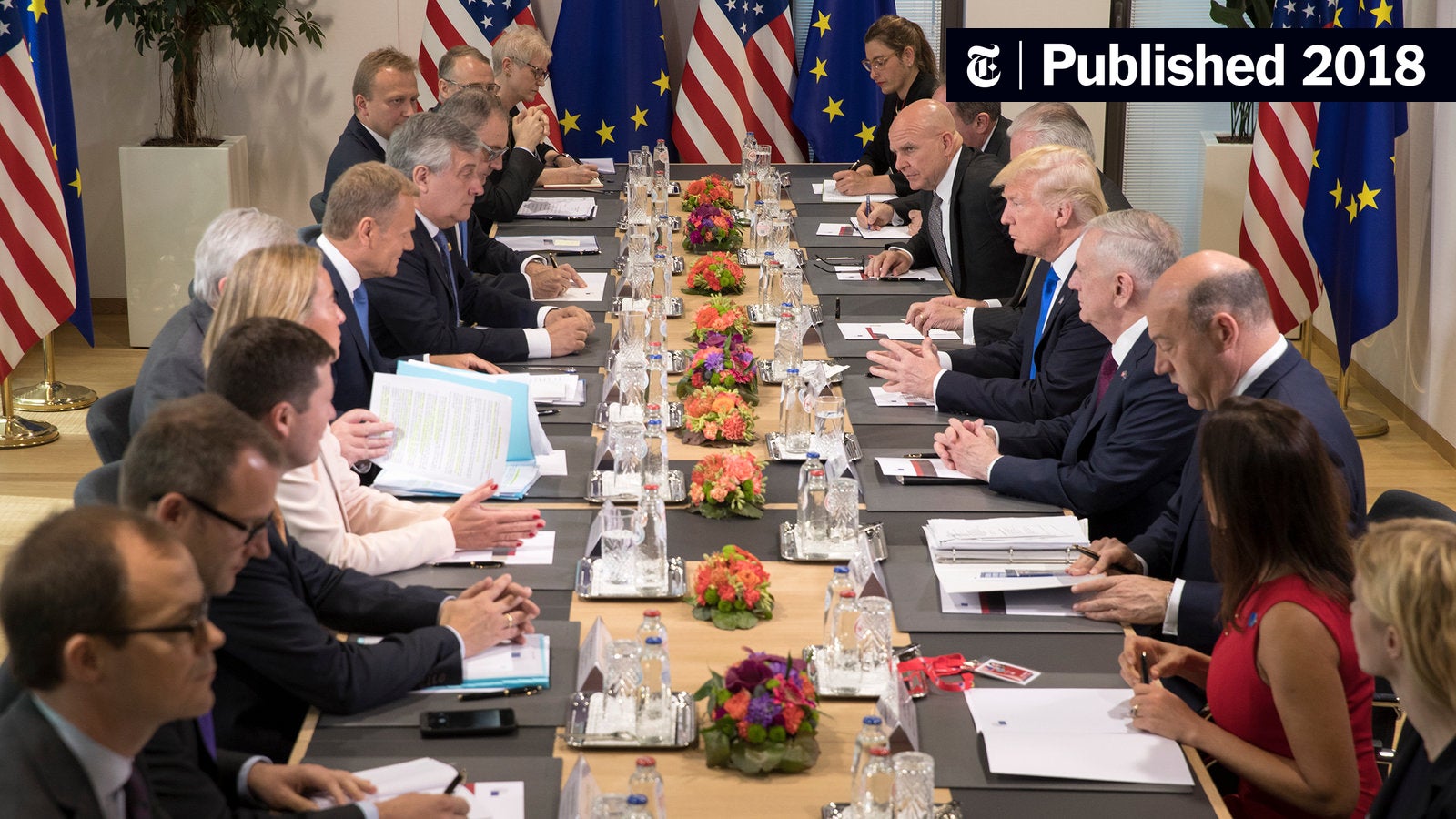European Union Stands Firm Against Trump Administration's AI Stance

Table of Contents
Divergent Approaches to AI Regulation
The EU and the Trump administration held fundamentally different philosophies regarding AI regulation. This divergence stems from contrasting priorities and visions for the future of AI.
EU's Emphasis on Ethics and Data Privacy
The EU prioritizes ethical considerations and robust data protection above all else. This is clearly demonstrated in the General Data Protection Regulation (GDPR) and the proposed AI Act. These initiatives aim to create a responsible and trustworthy AI ecosystem.
- Focus on explainable AI: The EU pushes for AI systems that are transparent and understandable, allowing users to comprehend how decisions are made.
- Algorithmic transparency: The EU advocates for mechanisms to understand the logic behind AI algorithms, promoting accountability and reducing bias.
- Data minimization: The EU emphasizes collecting only the necessary data for a specific purpose, minimizing potential misuse and risks.
- Right to explanation: Individuals should have the right to understand and challenge AI-driven decisions that affect them.
- Protection against bias: The EU aims to develop AI systems that are free from discrimination and prejudice.
The GDPR, already in effect, mandates stringent data protection measures, affecting how companies collect, process, and store personal data. The proposed AI Act goes further, classifying AI systems based on risk levels and imposing specific obligations on developers and deployers. This includes stringent requirements for high-risk AI systems used in areas like healthcare and law enforcement. The impact is significant: it shapes AI development, deployment, and innovation within the EU and influences global standards.
Trump Administration's Focus on Innovation and Deregulation
In contrast, the Trump administration favored a less interventionist approach to AI, prioritizing rapid technological advancement and economic competitiveness over stringent regulations. The focus was on fostering innovation through minimal government interference.
- Limited oversight: The absence of a comprehensive federal AI strategy meant less government oversight and fewer regulations on AI development and deployment.
- Emphasis on market forces: The belief was that market forces would naturally drive responsible AI development and address ethical concerns.
- Concerns about stifling innovation: Heavy regulation was seen as potentially hindering innovation and US global competitiveness in the AI sector.
This approach, while aiming to boost innovation, left significant ethical and societal concerns largely unaddressed. The lack of a cohesive federal strategy contrasted sharply with the EU's proactive and comprehensive approach.
Key Areas of Conflict
The differing philosophies of the EU and the Trump administration led to significant conflicts in several key areas.
Data Privacy and Cross-Border Data Flows
The EU's stringent data protection rules, particularly the GDPR, clashed directly with the Trump administration's more lenient approach, creating substantial obstacles for transatlantic data sharing.
- GDPR compliance challenges for US companies: US companies operating in the EU faced significant challenges in complying with the GDPR's strict data protection requirements.
- Data localization requirements: The EU's emphasis on data localization, requiring data to be stored within the EU, further complicated transatlantic data flows.
- Potential trade barriers: These differences created potential trade barriers and hindered international collaboration on AI projects.
This conflict significantly impacted international collaborations and data-driven AI development, creating friction between businesses operating on both sides of the Atlantic.
AI Ethics and Bias Mitigation
The EU's strong focus on ethical AI development, including measures to mitigate algorithmic bias, contrasted starkly with the Trump administration’s less pronounced emphasis on these issues.
- Lack of focus on AI bias in the US: The US lacked a strong federal focus on addressing algorithmic bias and its potential societal consequences.
- EU's proactive approach to ensuring fairness and accountability: The EU adopted a proactive approach, aiming to ensure AI systems are fair, accountable, and transparent.
- Different approaches to risk assessment: The EU's risk-based approach to AI regulation differs significantly from the US’s more laissez-faire approach.
This difference in approach highlights the potential societal consequences of biased AI systems and the EU's attempts to prevent them through proactive regulation.
International Cooperation and AI Governance
The contrasting approaches significantly hampered international cooperation on establishing global AI standards and norms.
- Difficulty in harmonizing regulations: The differing regulatory landscapes made it difficult to harmonize regulations and create a unified global approach to AI governance.
- Potential for fragmentation of the AI market: The divergence could lead to a fragmented AI market, with different regulatory standards in different regions.
- Impact on global AI leadership: This lack of harmonization impacts global AI leadership and the ability to address common challenges.
The lack of a unified approach hinders effective international collaborations and slows progress toward a globally consistent and responsible AI ecosystem.
Long-Term Implications and Future Outlook
The Biden Administration's Shift in Approach
The Biden administration has indicated a potential shift toward a more regulated approach to AI, suggesting a departure from the Trump administration's stance. This shift might lead to increased collaboration with the EU.
- Possible areas of convergence and divergence: While areas of convergence are likely, significant differences might remain, particularly regarding the level of regulation and enforcement.
- Potential for increased collaboration: Increased cooperation on AI governance and standards between the EU and the US is possible under the Biden administration.
- Challenges in bridging the existing gap: Bridging the existing regulatory gap and fostering trust will remain a significant challenge.
The future of transatlantic cooperation on AI policy remains uncertain but presents opportunities for increased collaboration and the establishment of shared AI governance principles.
Conclusion
The European Union's steadfast commitment to ethical and responsible AI development stands in stark contrast to the Trump administration's previous approach, highlighting significant transatlantic differences in AI governance. These differences created challenges for international cooperation and raised concerns about potential trade barriers and fragmentation of the AI market. Understanding the EU's AI stance versus the previous US approach is crucial for navigating the complexities of the global AI landscape. Stay informed on the evolving regulatory environment surrounding artificial intelligence by following further developments on the EU's AI Act and the Biden administration's policies. Further research into the EU AI stance vs. US policy will help clarify the future of AI development and governance.

Featured Posts
-
 False Greenland Reports Denmark Russia Tensions Escalate Amidst Us Involvement
Apr 26, 2025
False Greenland Reports Denmark Russia Tensions Escalate Amidst Us Involvement
Apr 26, 2025 -
 Discover 7 Exciting New Orlando Restaurants In 2025 Beyond Disney
Apr 26, 2025
Discover 7 Exciting New Orlando Restaurants In 2025 Beyond Disney
Apr 26, 2025 -
 Karen Reads Murder Cases A Year By Year Breakdown
Apr 26, 2025
Karen Reads Murder Cases A Year By Year Breakdown
Apr 26, 2025 -
 Are Chinese Vehicles A Viable Alternative A Detailed Assessment
Apr 26, 2025
Are Chinese Vehicles A Viable Alternative A Detailed Assessment
Apr 26, 2025 -
 Investing In The Future A Look At Reselling Stakes In Musks Private Companies
Apr 26, 2025
Investing In The Future A Look At Reselling Stakes In Musks Private Companies
Apr 26, 2025
